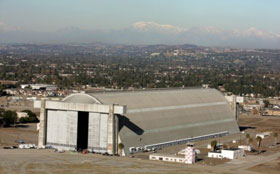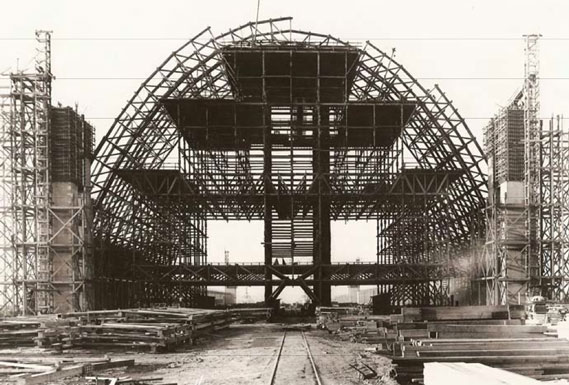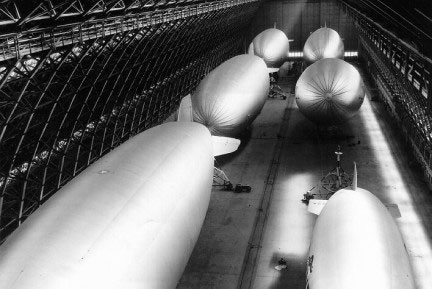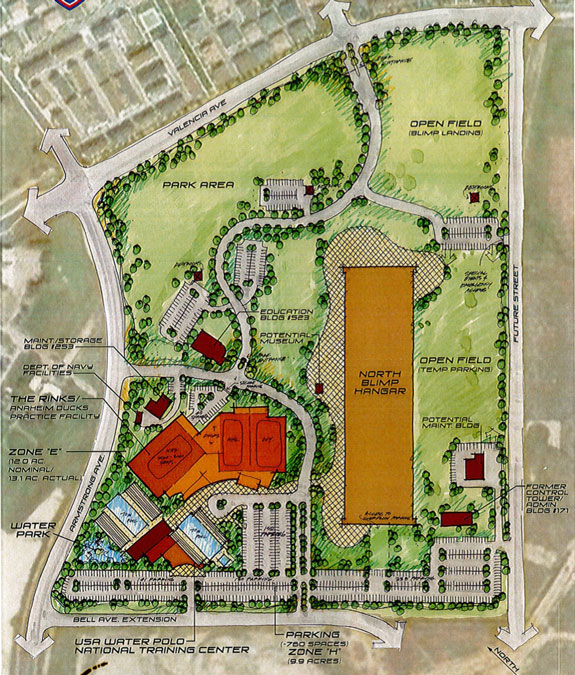
Photo by Jebb Harris – Orange County Register
Last week the Orange County Parks Commission voted unanimously to approve a reuse plan for one of the landmark blimp hangars at the former Tustin Marine Corps Air Station. The approved concept plan involves restoring the north hangar and transforming the surrounding 84.5 acres into a regional park that will feature playing fields, tree lined trails, playgrounds and picnic areas. Future uses may also include water polo and ice hockey facilities. Due to its poor condition, the southern hangar is slated for demolition.
Having lived within several miles of this former base prior to my move out of Orange County, I drove by the two massive hangars on a weekly basis. While I never had the opportunity to get inside them, they captivated my imagination nonetheless, due to their sheer size, fascinating history and potential for creative reuse.
The hangars were built in 1942 shortly after the United States entered World War II. At the time, the War Department (renamed the Department of Defense in 1949) sought locations for Lighter-than-Air squadrons (aka blimps) around the country as a means of protecting the nation’s coasts. Orange County was selected as the area to house and maintain blimps intended to patrol for enemy submarines along the southern California coast from San Diego to Santa Barbara.
Orange County was an ideal location for this facility due to its small population and rural character. The large 1,600 acre swath of land selected by the military for the blimp base supported highly productive lima bean fields and was situated on Irvine Ranch land adjacent to the cities of Tustin and Santa Ana.
After rather contentious negotiations between the government and James Irvine II, the Navy began construction of the hangars and surrounding support facilities on April 1, 1942. A short six months later, the Naval Air Station Santa Ana was commissioned on October 1, 1942.
Each hangar was built to house six blimps and measured 1,088 feet long by 297 feet wide. Both are 178 feet tall (over 17 stories).

Hangar under construction circa 1942

Naval Air Station Santa Ana circa 1945

US Navy Blimp 1943

Six blimps inside one of the Tustin Hangars – May 1945
Because materials were in short supply during the war and steel was needed to produce ships and weapons, the hangars were constructed out of wood, a domestically produced, readily available resource. At the time of their construction, they were the world’s largest clear span wooden structures. They remain so today. Due to their unique design, mammoth size and fast construction schedule, the American Society of Civil Engineers named them one of the “Historic Civil Engineering Landmarks” of the 20th Century in 1993.

North Hangar (aka Building 28) 1999
In 1949, the Navy decommissioned the air station. The Marine Corps then took control of the facility in 1951 and used it as its main west coast helicopter base. According to an article by Paul Freeman for the California State Military Museum web site, “the unique facilities at Tustin were very well suited to large-scale helicopter operations, as the blimp hangars were capable of providing indoor storage for huge numbers of helicopters, and the blimp mooring pad provided acres of ramp space for parking. At its peak, Tustin housed over 100 helicopters.” The Marine Corps closed the base in 1999, setting the stage for the site’s redevelopment.
The next step in the redevelopment approval process is for the Orange County Board of Supervisors to consider the plan, which will likely happen at their January 24th meeting. If approved, construction on this $70 million project could get underway in 2014, with the park opening in 2016.
Concept Site Plan – OC Regional Park

Produced by Woodley Architectural Group for OC Parks Commission
Concept Animations Presented to the Commission
Want to Learn More?
Concept Plan – Regional Park at Former MCAS Tustin
The Tustin Hangars: Titans of History


Follow Us!